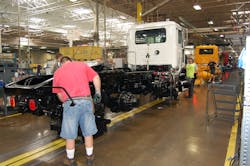With preliminary Class 8 net orders for November dropping below expectations, alongside broader declines in U.S. manufacturing and non-manufacturing activity, there’s growing concern among analysts that the trucking industry may be poised to hit a rough patch far sooner than expected.
“Based on what we were seeing, we thought freight and truck sales would stay strong through the end of 2015 and into 2016, with a downturn beginning at some point in the second half of 2016,” Kenny Vieth, president & senior analyst with ACT Research Co., told Fleet Owner.
ACT’s previous forecast held that 2017 would be the “horrible year” for trucking, but Vieth said some new factors seem to be speeding up its approach.
“We didn’t fully anticipate the big sustained drop in commodity process – especially the price of oil – and the strong dollar, which means the U.S. is exporting less,” he explained. “Falling commodity prices means freight is drying up and that is freeing up [truck] capacity. Meanwhile, exporting less means manufactures like Caterpillar can’t sell as many machines overseas, so they start producing less and that reduces freight further.”
Don Ake, VP-commercial vehicles for research firm FTR, added that other data metrics – such as weak retail sales and rising inventories – also slowed freight demand.
“We got worried because inventories increased over the last three months at a time when they should have been falling,” he told Fleet Owner. “Meanwhile, retail sales have declined in each of the last four months. They are down 6% at a time when they should be up between 5% and 10% due to the [holiday] season.”Though FTR predicted in September that truck and trailer sales would start falling in 2016, Ake said the Class 8 order trends through the summer into early fall gave all the indications of a “soft landing,” especially since August’s Class 8 net orders hovered around the 19,000 unit mark.
“We figured, if that’s the bottom of the cycle, that’s not bad; we’ll be OK coming out of summer and experience a soft landing,” Ake said.
But when FTR’s preliminary North American Class 8 truck net orders hit 16,475 units in November, 59% below a year ago and the lowest level since September 2012, Ake characterized it as a “major disappointment.”
“This was the weakest November order activity since 2009, coming in significantly below expectations,” he explained. “All of the OEMs, except one, experienced unusually low orders for the month.”
Ake added that a sub-16,500 unit order rate “doesn’t support our forecast” for 272,000 total North American Class 8 sales for 2016; a forecast already slashed 15% from the firm’s September guidance of 290,000 units.
“There’s significant downside to our forecast now,” he said. “Basically, the industry would appear to have enough new trucks for now.”
In terms of the broader U.S. economy, Lindsey Piegza – chief economist at Stifel Fixed Income – noted some other troubling trends for trucking, with the Institute for Supply Management (ISM) non-manufacturing Index falling from 59.2 to 55.9 in November, marking the lowest reading since May.
Also, she said durable goods orders were revised down from a 3% increase in October to 2.9%, leaving the annual rate downgraded to 0.4%. Capital goods orders excluding aircraft and defense – a proxy for business spending in the GDP [gross domestic product] calculation – also stood unchanged at 1.3% in ISM’s final October report and up 0.4% year-over-year.
“Despite a decline in manufacturing production, the service sector had been able to maintain robust levels of activity, at least until now,” Piegza said in a research update. “At this point, however, the service sector, too, appears to be losing momentum amid lingering barriers to growth such as modest hiring and minimal income gains, pulling service activity down to the weakest reading in six months.”
She stressed that as a more pronounced sector relative to manufacturing accounting for more than a third of the economy, should service activity continue to retreat, “the U.S. economy will have little hope of maintaining the status quo, let alone gain momentum as we head into the New Year.”
FTR’s Ake noted that all of this is going to make December “a critical month” in terms of the future direction of North America Class 8 net orders.
“If we see a number above 25,000 units, we’ll be OK. And that has happened before; in 2013 we got ‘faked out’ by poor November orders of 21,000 and then they shot up to 31,000 that December. It could happen again,” he said.
“But if we get a number under 20,000 units, that’s a problem,” Ake warned.
About the Author
Sean Kilcarr
Editor in Chief
Sean Kilcarr is a former longtime FleetOwner senior editor who wrote for the publication from 2000 to 2018. He served as editor-in-chief from 2017 to 2018.

